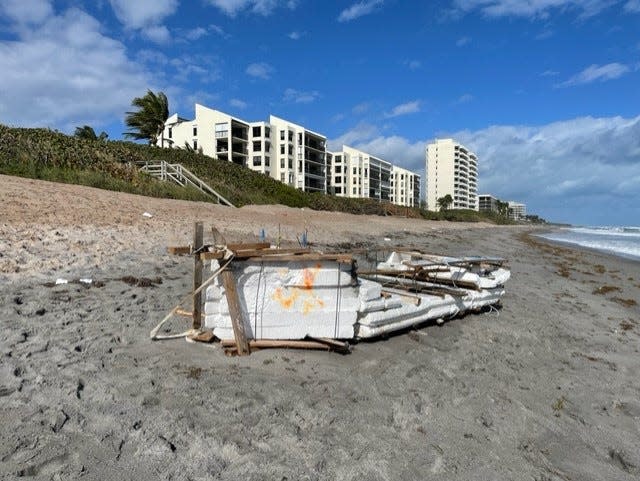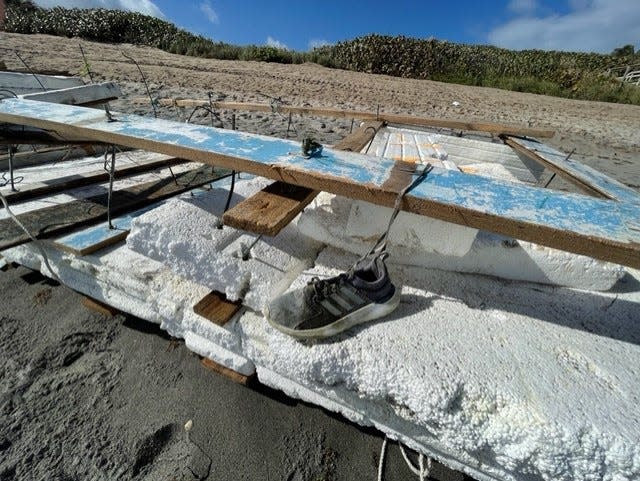Build a multinational taskforce to help Haiti | Commentary

Many mornings I walk along sections of the largely unspoiled beach that runs in front of our winter home on Jupiter Island.
On a handful of mornings during the past six years that we have lived here, I have encountered the battered remains of rickety “boats” that carried desperate migrants to our shores. A number landed successfully with some or all of their passengers surviving the journey and fleeing into the thick mangroves and sea grapes that guard our beach before being captured or heading off to points unknown. Many others likely met a more uncertain fate with an unknown number perishing at sea.
This morning I encountered a particularly chilling sight. It was the remains of a handmade craft constructed of panels of Styrofoam, wooden planks and re-bar. There was evidence that it had once had an engine as an uncoupled propeller shaft was the sole evidence of any mechanical device. It came ashore upon one of the many areas on our island where there are rugged limestone reefs a few yards off the beach. We had been experiencing high seas and pounding surf for several days and the punishment that this craft endured as it was raked across the reef was evident. It is doubtful that anyone could have survived this journey, given recent sea conditions, as well as the merciless beating that it would have experienced once it entered the surf line. The lone sneaker dangling from the makeshift gunwale nearly brought me to tears. I stared slack-jawed thinking “what level of desperation would prompt someone to set out across the sea in such a sad contraption?”
Mystery solved: Beachgoers see odd giant structure float by Palm Beach County's coast
More: Coast Guard ends search for survivors of capsized boat in suspected 'human smuggling' case
Florida beaches see some weird things wash ashore: Here are some of the strangest items

I had the privilege of serving a combined 26 years of active and reserve service in the U.S. Coast Guard. I also served in the White House for two presidents and in the Pentagon as a Deputy Assistant Secretary of Defense. During my years of federal service, I had the opportunity to travel to developing nations around the world in such far flung places as West Africa, Latin America and the Caribbean basin…including Haiti. It was a world class education in different cultures, and I had the opportunity to observe the impact of despotic regimes, corruption, rampant violence, hopeless poverty, hunger and disease on some of the poorest people on the planet. I remember many heartbreaking sights.
There are precious few nations on the face of the planet that have endured the natural and man-made ravages that have befallen the people of Haiti, once the most successful colony in the Caribbean.
Located atop a notoriously unstable seismic fault and in the heart of the so-called “hurricane belt,” Haiti has often found itself in the crosshairs of natural disasters. Having little infrastructure to help endure the ravages of nature, natural disasters have wreaked outsized impacts. Between 2004 and 2008 Haiti was pummeled by three major hurricanes and a deadly tropical storm. More than 3,000 were killed and hundreds of thousands were made homeless. The year 2010 was a particularly deadly year for Haiti when it suffered a magnitude 7.0 earthquake that killed more than 200,000 people and left 1.6M homeless. In the same year, a cholera epidemic wiped out more than 10,000 people. As recently as last August, Haiti was again hit by a massive earthquake that killed more than 2,250 people and left yet another 650,000 homeless.
Man-made catastrophes have had an equally deadly impact on Haiti. For much of its history, Haiti has suffered at the hands of corrupt and incompetent governments and the, sometimes well intended, but ham-handed meddling of foreign nations, often the United States. The current acting prime minister has been accused, by some, of being complicit in the assassination of the last one. Meanwhile, as a corrupt and makeshift replacement of a viable government, some 90 criminal gangs control nearly every aspect of daily life.
We bear a special responsibility to Haiti, a nation crumbling on our doorstep. Many of Haiti’s problems can be directly traceable to the bizarre combination of neglect and bumbling interference that has been the hallmark of U.S. policy for decades. Countless human beings will continue to die on the Straits of Florida, the Windward Passage, the Bahama Bank and the Cay Sal Bank, risking everything to get to our shores unless things change quickly.

U.S efforts, led by USAID and primarily consisting of disaster funding, have largely proven ineffective in dealing with the root causes of Haiti’s collapse. Congress must authorize the Administration to create and lead a multinational coalition of hemisphere partners, Caribbean nations and legacy nations (France and Spain) that will contribute military, judicial, law enforcement, humanitarian, medical, industrial, educational, governmental, commercial, NGO and other necessary components to a Haiti Reconstruction Task Force.
The U.S. and its allies have, for generations, sent forces around the globe, often to areas where there was a much less clearly defined national interest. Helping to rebuild Haiti is a moral, practical and strategic imperative. It cannot wait.
Robert Kelly, a winter resident of Jupiter Island, is a former Coast Guard officer and former deputy assistant secretary of defense.
This article originally appeared on Palm Beach Post: Commentary: The U.S. must create a multinational task force for Haiti

